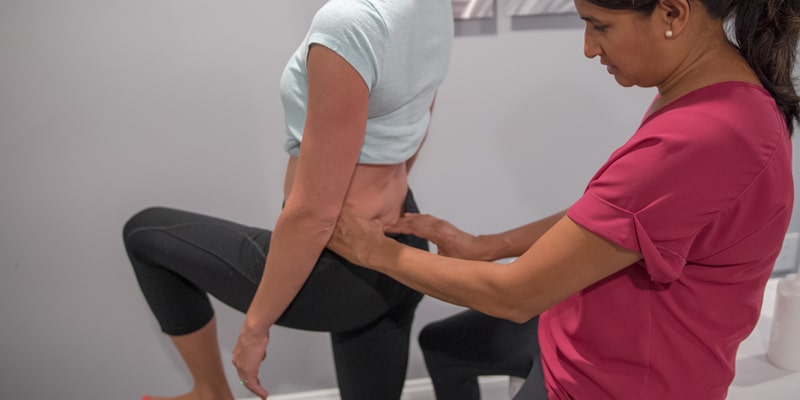Pregnant women’s back pain can be treated in a variety of ways, some of which depend on the stage of pregnancy, the origin of the pain, the severity of the pain, and the presence or absence of other medical disorders like diabetes or heart disease.
When everyday functioning and social engagement are considerably impaired, life quality, it may be necessary to pursue how to treat chronic pain by both medical and psychological therapy.
Obstetricians, orthopedic specialists, neurologists, and neurosurgeons may all be involved in the management process. A patient’s posture, leg range of motion, leg length inequality, tendon reflexes, gait pattern, joint pain, and lumbar spine curvature are all assessed by a doctor.
The primary objectives of treating back pain during pregnancy are to keep the patient as functionally as possible and as pain-free as possible.
When conservative measures like observing for and treating warning signs and symptoms and medical management fail, surgery may be an alternative. But before that, try any of the following steps in managing chronic pain to relieve pain in your back while pregnant.

Correct Your Posture
The tension and strain on the tissues of the lower back can be significantly reduced by maintaining an ergonomically supported posture throughout the day. Rest, avoiding overuse and high-impact activities, and strengthening exercises for the hips, pelvis, and lower back are also recommended by medical professionals.
Some painkillers, such as nonsteroidal anti-inflammatory drugs (NSAIDs), should be avoided during pregnancy because of safety concerns.
Use an Ergonomically Designed Bed
In pregnancy, it’s best to sleep on your side with the help of some good pillows. If you sleep with a pillow wedged in between your knees and ankles, you can relieve some of the pressure on your lower back by bringing the top of your knees to the same level as your hips.
When a vertical cushion is positioned at the midsection and upper torso, it can provide needed support for the upper arms and chest.
To help keep the head and neck in a comfortable position while sleeping, try placing a small rolled-up towel inside your pillowcase and tucking it under your neck.

Sit With a Lumbar Roll
Reduce the occurrence and severity of back pain by maintaining an ergonomically supported sitting posture throughout long work or study sessions.
It is advised to sit up straight, with the ear lobes, shoulders, and hips all in a straight line. To aid in maintaining the natural curve of the spine, a lumbar roll can be placed in the small of the back.
Those who experience pelvic pain after rising from a seated posture may find relief with this roll. As their bodies expand and their postures shift during pregnancy, pregnant women benefit most from using inflatable lumbar rolls.
It is advisable to take short breaks every hour to stretch and stroll about (if possible). Reducing the amount of time spent standing and walking can help ease chronic pain.
Chronic back and leg pain during pregnancy can be alleviated with the use of a maternity support brace and shock-absorbing walking shoes. In general, you should sit down every so often and avoid doing anything that requires you to stand or walk for long periods of time.
Sore Tissues Benefit from Rest and Heat Therapy
Muscle spasms and sudden pain can be alleviated by taking periodic naps throughout the day. When resting, bending the hips and reducing sagginess in the lower back might be aided by propping up the feet.
A heat patch applied to the lower back and/or pelvic area can alleviate pain, relax tight muscles, and promote better blood flow. The heat source needs to be safe to use for 20 minutes at a time, with 15 minutes of use per session. If you want to protect yourself from burns, you should use a barrier, such a towel.

Strength and Stamina are Improved by Exercise and Physical Therapy
The primary goals of treating chronic back pain in pregnancy are to keep you as functional as possible and as comfortable as possible.
Range-of-motion and flexibility drills, as well as exercises to strengthen the back, are all part of physical therapy. Pregnant women can benefit from physical therapy and exercise programs designed specifically for them by a licensed therapist to strengthen the muscles and connective tissues that support the lumbar spine (lower back).
By flexing (or bending forward), you can strengthen your abdominal muscles, your core, and your spine, all of which contribute to a flatter back and less lumbar curvature.
Back bending (extension exercises) assist strengthen the paraspinal muscles, which stabilize the spine.
Pelvic tilts, knee-to-chest stretches, straight leg raises, curl-ups, side-lying leg raises, and the Kegel exercises are all examples of low-impact physical therapy and exercise options that can help alleviate back pain during pregnancy.
Fetal Complications can be Avoided by Using a Safe Pain Reliever
Drugs of any kind are taken with extreme caution during pregnancy to protect the unborn child from any possible side effects. Certain medications are only deemed safe in the second and third trimesters of pregnancy, and even within this group, there are several that should be avoided in the first.
Acetaminophen is a first-line medication for pain associated with back discomfort and the pelvic region during pregnancy because of its low risk of side effects.
Anticonvulsants (gabapentin) or antidepressants (amitriptyline) may be administered with caution for short-term treatment for nerve pain, such as in sciatica or radiculopathy.
Opioid drugs, while sometimes prescribed for severe or debilitating pain, must be given with prudence to prevent withdrawal symptoms in the baby.
Pregnant women should always check with their doctors before taking any kind of drug, whether it be prescription or OTC, or even a dietary supplement.

Chronic Pain Treatment Options with Conventional Medicine
The following therapies are examples of safe pregnancy pain management strategies that may be used in conjunction with traditional medicine or as an alternative option:
- Hand-on treatment based on acupuncture
- Water-based treatment
- Medical devices that stimulate nerves electrically through the skin (TENS)
- Braces intended to support the abdomen during pregnancy
- Yoga
Evidence suggests these therapies are effective when taken in conjunction with the advice of a medical practitioner.
Constant pressure on the lower back, hips, pelvis, and legs is the root cause of pregnancy-related back pain. Pregnant women who adhere to recommended treatment procedures and who participate in back and core strengthening therapy early in their pregnancies may be able to avoid or significantly lessen the severity of back pain.
Finally
For more information on chronic pain management, pain disorders, chronic pain resources, psychogenic pain, effective chronic pain treatment options or other physical therapy, you should book a consultation session with a specialist at Chronic Therapy today, to give you professional advice that will suit your personal experience.
Also, for people with chronic pain who are constantly worried on how to treat chronic pain or get their chronic pain treated, our specialist at Chronic Therapy have made huge success over the year in recommending reliable resources to manage chronic pain from nerve pain or any other developing chronic pain conditions.
More to read: CBD Oil for Autism: Uses and Benefits

